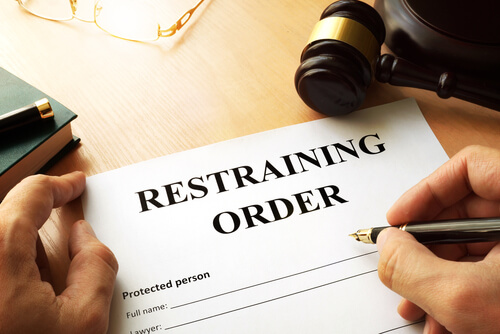Stalking and Harassment Guide
Harassment and stalking are often used as interchangeable terms. However, they relate to similar but different offences that can cause victims, their families and loved ones physical, psychological, and emotional harm.
Offenders can stalk or harass their victims in a number of different ways, including:
- a text, message, voice mail, letter, or email
- a comment or threat in person or online (e.g., social media or online chat rooms)
- standing outside someone’s house or driving past it
- an act of violence
- damage to someone else’s property
- maliciously and falsely reporting someone to the police without any wrongdoing
The Office for National Statistics (ONS) estimates that 2.5 million people every year experience stalking in England and Wales.
What is Harassment?
Harassment is unwanted behaviour from someone else that makes you feel alarmed, distressed, humiliated, or threatened. To count as harassment, these behaviours must have happened more than once. Examples of harassment include:
- unwanted phone calls, texts, letters, emails, or visits
- abuse (verbal or online)
- physical gestures or facial expressions
- images and graffiti
- threats
- sending unwanted gifts
What is Stalking?
Stalking involves persistently following someone. It does not necessarily mean following them in person and can include watching, spying, or forcing contact with the victim through any means, including via social media. The Suzy Lamplugh Trust defines stalking as
‘A pattern of fixated and obsessive behaviour which is repeated, persistent, intrusive and causes fear of violence or engenders alarm and distress in the victim’
Stalking behaviour can include:
- making unwanted communication
- damaging property
- regularly following someone
- watching or spying on someone
- hanging around somewhere they know the person often visits
- checking someone’s internet use, email or other electronic communication
The UK police provide four warning signs of stalking:
- Fixated
- Obsessive
- Unwanted
- Repeated

Stalking and Harassment in the Workplace
Stalking and harassment can occur anywhere, including at work. In this context, stalking falls into several categories:
- Stalking from outside of work coming into the workplace
- Clients stalking staff
- Clients stalking other clients
- Staff stalking co-workers
- Staff stalking clients
All workplaces have a moral and legal obligation to manage stalking behaviour and support victims as far as reasonably practical. The most effective way to do this is to implement thorough processes that outline what constitutes inappropriate contact at work and ensure all employees are aware of what to do in an incident. This stalking policy should then be reviewed at least annually and any time an incident occurs.
To further prevent incidents of stalking and harassment, you should ensure your workplace is a safe place for all. This means you should review relevant risk assessments and security procedures such as site access, car park lighting and personal safety training. Employees should be reminded of GDPR and data protection policies to ensure that personal information is never given out; this includes phone numbers, work hours or days and email addresses.
It should also be made clear to employees that the victim will always have your support. By creating an environment where employees feel able to raise concerns you will be able to better understand and manage any arising situations.
Offering employees access to a personal safety service, such as Peoplesafe, can help to boost confidence and wellbeing. Using either an SOS app or dedicated personal safety alarm, staff are supported 24/7 by a professional Alarm Receiving Centre (ARC) which is able to summon help via emergency services or escalation contacts, depending on the situation. Importantly, in the cases of stalking and harassment, the technology utilised to enable the service automatically records audio of any SOS alarm raised which can be submitted as empirical evidence to support prosecutions.
Harassment and Stalking Law
The Protection from Harassment Act 1997 (PHA) outlines harassment offences as ‘causing alarm or distress’ (section 2), and ‘putting people in fear of violence’ (section 4).
The behaviour must happen on more than one occasion by the same person or group to be considered harassment; however, it can be different types of behaviour on each occasion. For example, a single threatening comment on social media is not harassment. Two comments or one comment and a text message may be considered harassment.
The Protection of Freedoms Act 2012 created two new offences, effectively identifying stalking as a criminal offence:
- Section 2A: Stalking – harassment which involves a course of conduct that amounts to stalking
- Section 4A: Stalking which can be committed in two ways, namely
- Stalking involving fear of violence
- Stalking involving serious alarm or distress
Although stalking isn’t legally defined, section 2A (3) of the PHA 1997 lists a number of behaviours associated with stalking, including:
- following a person
- contacting, or attempting to contact, a person by any means
- monitoring a person’s use of the Internet, email or any other form of electronic communication
- loitering in any place (public or private)
- interfering with any property in the possession of a person
- watching or spying on a person
Furthermore, the offence outlined in section 4A states that the defendant’s behaviour has a substantial adverse effect on the victim’s usual day-to-day activities. This may include:
- the victim changing their route to work, work patterns or employment
- the victim arranging for someone else to pick up their children from school
- the victim putting additional security measures in place at home
- the victim changing the way they socialise or stopping altogether
The offences focus on the cumulative effect of stalking on the victim instead of looking at specific incidents in isolation.
Ultimately, it’s up to the courts to decide if something is harassment or stalking under the Act. Using the same set of behaviours, the courts will consider whether a reasonable person would interpret them as harassment.
What is the Maximum Sentence for Harassment or Stalking?
According to the UK Sentencing Council, if the offence is harassment or stalking:
- the maximum sentence is six months’ custody
- if racially or religiously aggravated, the maximum sentence is two years’ custody
If the offence is harassment (putting people in fear of violence) or stalking (involving fear of violence or serious alarm or distress):
- the maximum sentence is 10 years’ custody
- if racially or religiously aggravated, the maximum sentence is 14 years’ custody
Within these guidelines, sentences are calculated by assessing culpability and harm.
- Culpability is a measure of how responsible the offender was for the harassment or stalking. An indicator of high culpability would be if the harassment was sophisticatedly planned. An indicator of lesser culpability would be if the harassment was limited in scope and did not last for long.
- Harm is a measure of the distress caused to the victim as a result of the harassment or stalking. This could be evidenced by the victim having to make considerable changes to their lifestyle e.g., moving house or changing jobs.
Online Harassment and Cyberstalking
The advancement of technology has certainly made everyday life easier, but it’s also opened up new opportunities for stalking and harassment.
Cyberstalkers are driven by the same intention as non-digital stalkers which is to threaten or embarrass their victims. The difference is that they rely on technology such as social media, instant messaging and emails to do this. Everything on the internet can be used by cyberstalkers to make unwanted contact with their victims.
There are different types of online stalking, including:
- Catfishing
- Virtually visiting victims via Google Maps Street View
- Hijacking webcams
- Looking at geotags to track a person’s location

It’s important to try and protect yourself against cyberstalkers by limiting the amount of information that’s readily accessible about you online. Essentially, you need to test your ‘Googleability’ by running a simple search of yourself on the search engine.
In terms of social media, you should review your privacy settings and limit the visibility of your account so that only your friends and followers can see your updates, personal information, and photos.
What Can The Police do About Harassment?
If you feel as if you’re being harassed or stalked, you can report it to the police or apply for an injunction through civil court. It is a criminal offence for someone to harass you or to put you in fear of violence.
To get in contact with the police, either visit your local police station or call 101 – the non-emergency number – and make an appointment.
1. Stalking Protection Orders
Stalking Protection Orders (SPOs) are not an alternative to prosecution but are intended to protect any person of any age experiencing stalking by using prohibitions and/or positive requirements as well as imposing notification requirements on the suspect. They allow for:
- early police intervention
- pre-conviction
- stalking behaviours to be addressed before they escalate in severity
Who can apply for an SPO?
An SPO application can be made by the police where it appears that:
- the suspect has carried out acts associated with stalking
- the suspect poses a risk of stalking someone
- there is reasonable cause to believe the proposed order
How long do SPOs last?
An SPO lasts for a fixed period (of at least two years from the date of the order) and will be specified in the order or until a further order is made. Different time limits may be specified in relation to each prohibition or requirement. A person who breaches an SPO or an interim SPO commits a criminal offence and will be investigated by the police.
2. Injunctions
If the abuser isn’t charged by the police, you can apply for an injunction through a County Court under the PHA 1997 or under the Family Law Act 1996 Part IV.
An injunction can forbid an abuser from doing certain things such as contacting you directly or indirectly, going to your home address, place of work or children’s school.
If you’re associated with your abuser, you might prefer to apply to the Family Court for a domestic violence injunction called a non-molestation order. There is no court fee for this application and legal aid is available.
You are associated with your abuser if you and your abuser:
- are or were ever married, engaged or in a civil partnership
- are or were living together (including as flatmates)
- are relatives (whether by blood, marriage, civil partnership or cohabitation)
- have a child together or have parental responsibility for the same child
- are or were in an intimate personal relationship of significant duration
Alternatively, you can apply for a harassment injunction against any person who has harassed or stalked you or put you in fear of violence by deliberately causing you distress on two or more occasions.
The orders must be reasonable and relevant to the harassment you’ve experienced. An injunction might include orders such as:
The defendant (i.e. abuser) is forbidden from coming with 200 metres of the home of the claimant.
What if my injunction is ignored or not followed by my abuser?
If the abuser breaks the injunction, you have two options:
- Report the breach to the police
- Make an application to return to the County Court where the injunction was made to enforce it
If your abuser is found guilty of breaking the injunction, they may be sent to prison for up to 5 years, fined, or both.
3. Restraining Orders
If the abuser is charged by the police and the case goes to the criminal courts, the court may issue a restraining order to protect you. A restraining order can be made even if the abuser is not found guilty.
Similar to an injunction, a restraining order prohibits your abuser from doing certain things; in addition, breaking a restraining order is a criminal offence. As a result of this, you cannot apply for one yourself.

How Can You Protect Yourself Against Harassment?
- Say no – tell the person once that their behaviour is inappropriate and that you don’t want any contact. Do not get into a dialogue with the abuser.
- Record what’s happening – keep any texts, emails or online comments as well as notes, including time and dates, of the harassing behaviour. Record any encounters with your abuser, such as what they say on phone calls, their actions and any relevant vehicle registration numbers. It’s also useful to document how this impacts you and your feelings.
- Contact the police – harassment and stalking are illegal, so if you feel threatened or uncomfortable, report it to the police as soon as possible.
- Confide in people – tell family, friends, neighbours and colleagues that you’re being harassed. They can also keep records of sightings and suspicious incidents as well as improve your safety when they’re with you.
- Trust your instincts – always trust your gut if something doesn’t feel right. If you are ever in a situation that feels unsafe, contact a trusted family member or friend and get to safety as soon as possible.
- Get advice – contact charities or organisations with harassment and stalking experts who will be able to provide guidance and support.
- Improve personal safety – always make sure that your mobile phone has sufficient battery in case you need to call the police in an emergency. If you often go out alone or walk by yourself, refresh your knowledge on personal safety tips you can incorporate into your daily life. Consider how you would respond if you were attacked and what you could do to diffuse a volatile situation.
- Invest in your safety – You can download a free personal safety app or find out whether your employer has invested in an enterprise-level personal safety service. They may have subscriptions for employees completing high-risk tasks and most employee safety technology providers will have solutions to meet the needs of low-risk staff. Typically this is in the form of a personal safety app which can easily be rolled out to workers looking for greater personal protection.
If you are ever in immediate danger, call the police on 999 or press the SOS button on your personal safety device.
Useful Links
For more advice on harassment and stalking, you can contact:
- The National Stalking helpline – 0808 802 0300 – www.stalkinghelpline.org
- The Suzy Lamplugh Trust – www.suzylamplugh.org
- Victim Support line – www.victimsupport.org.uk
- Paladin National Stalking Advocacy Service – www.paladinservice.co.uk
- Veritas Justice – www.veritas-justice.co.uk
- Action Against Stalking – www.actionagainststalking.org
- Protection Against Stalking – www.protectionagainststalking.org
- The Crown Prosecution Service – https://www.cps.gov.uk/legal-guidance/stalking-or-harassment
- College of Policing – https://www.college.police.uk/app/major-investigation-and-public-protection/stalking-or-harassment




